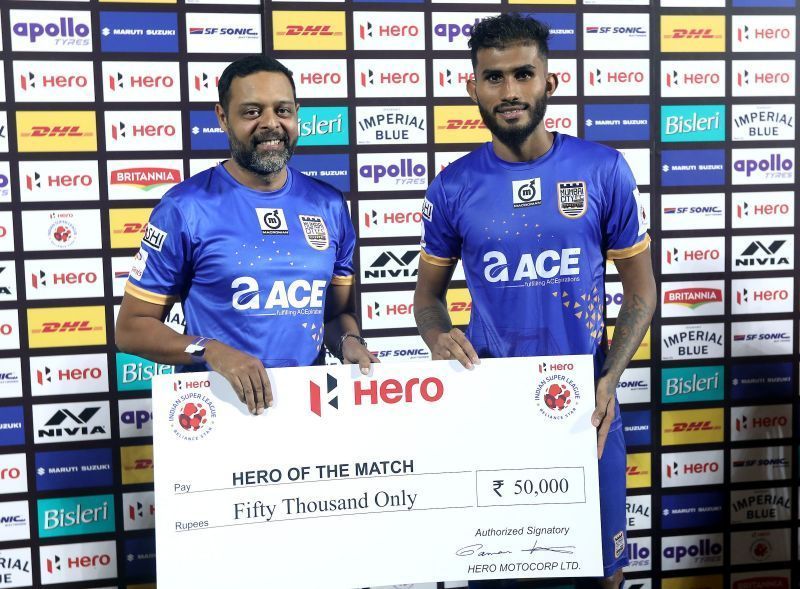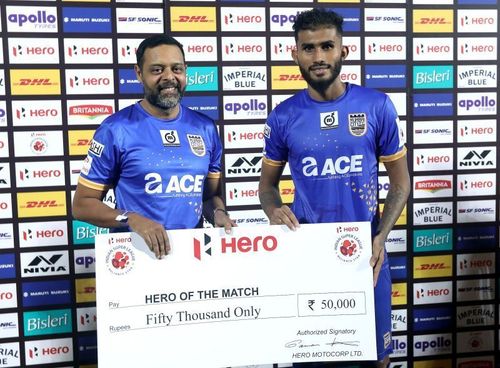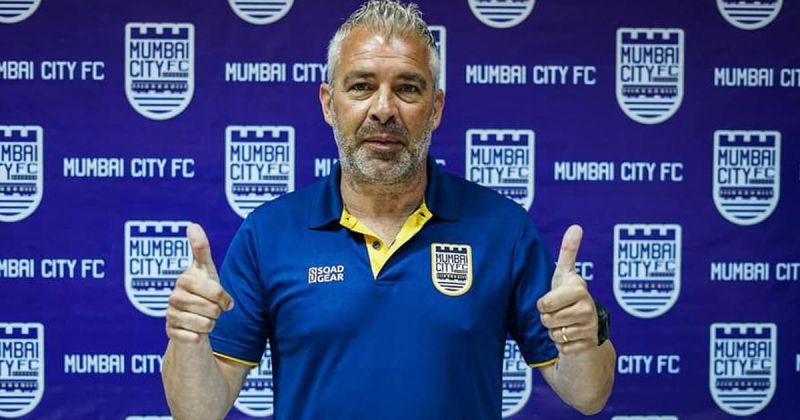
"Our challenge would be to replicate the successes of this year in season six," says Mumbai City FC CEO Indranil Das Blah

Back in our younger days, finding open spaces to play football was a significant achievement. If you've lived in the chockablock streets of Mumbai, you'd know what I'm talking about.
We started in the upper echelons when we played ball in the spacious and green Joggers Park. Having real grass under our shoes was truly a luxury. But pretty soon we were relegated when a stray shot broke a jogger's spectacles.
Then came the buildings. As soon as it was starting to get fun, a terribly inaccurate pass found a window and we had to find a new place to play.
But unlike a certain London club, we didn't have great issues finding a home ground and shifted play to the parking lot. And so the process continued.
Young dreamers did at some point think of making it professional though. But as we grew up, most of the guys fell into the trap, better known as engineering, medical, CA, you get the point.
But then there were these select few kids, who may not have made it pro, but they stuck to their guns, stuck to their studs, and chose to make a career in the field of their passion.
ALSO READ: Bengaluru FC the benchmark
One such inspiration is Indranil Das Blah, CEO of Mumbai City FC. The man from Shillong heads the backroom staff of the Indian Super League club and Sportskeeda was fortunate enough to sit down and speak with him. Here’s how that went:
So, what does a working day look like for the CEO of Mumbai City?
Matchday is pretty simple now, this is the fifth season so it's on autopilot. We have a set team, in fact, it's the only management team that's been constant in the ISL for 5 years now.
In the morning I get an update from the team manager and director of football, Watson, who takes me through the plans of the coach, the players that would be involved on the day. I get to the stadium by 6 and at that point, my main concern is hoping that people turn up, And during the game, I'm just watching on as a fan.
Pre-season though is hectic because you're seeking sponsors, doing multiple meetings with teams, travelling especially to Delhi since 80% of the brand universe is based out of the capital. So most sales happen during pre-season.
Then one month before the season kicks off, you start getting involved with the team. I spend a lot of time with the coaching staff, understanding the plans of the coach with the team. Even before that, of course, there are negotiations with the coach and the players.
Ok, could you give us an insight into the process of signing the coach and players?
That is driven by the technical team, which includes Watson, the director of football, and Narendra who's our chief analyst.
They work with the coach and the assistant to come up with favourites to sign. And unless I have a very strong opinion about a particular player, I won't get into deciding this, because I'm not a technical guy.
To give you an example, halfway through last season, we realised we weren't going to have a good season, so we started working immediately. By around February, we decided the Indians we wanted to retain and sign.
So before other teams began to think about it, we were already on the market. Guys like Shouvik Chakrabarti and Subhashish Bose - these guys were signed even before ISL 4 had concluded.
As soon as last season ended we went to get a coach. I give the technical team a budget, and they work backwards to shortlist about 10 coaches.
We further shortlist that to five coaches who we have a Skype call with. And then between Watson and me, we shortlist two coaches who we present to our owners.
Bimal (Parekh), being from a finance background, discusses that side of the deal while Ranbir (Kapoor) wishes to know more about the coach and his philosophy. So there are a fair few questions asked but eventually, they let us take the final call. After that, we negotiate with the coach before signing him on.
Once the coach is done, he tells us the positions he wishes to fill and the players he wants. We got a little lucky this year because the players we'd signed already fit well into Jorge Costa's philosophy.
He wanted hard-hitting players like Milan, Bose. Then the coach mentioned his players, like Paulo Machado, and once they fit into our budget, we negotiate with them.
Most Indians are selected by us (Indranil and his technical team), and the foreigners are picked by the coach and the technical team.

Nice. Skype interviews with a shortlist of football coaches - those must be interesting?
It's not very technical because you already know their CV and details of it. It's more about getting to know the person.
We've had interviews that lasted 10 minutes and then there were some that went on for two hours. With Jorge, it was a really long discussion. That's the bit I love about my job, you get to discuss football.
Of course, there's the hygiene question - why are you looking at India, which players are you looking to sign and why your plans going forward etc. But the interesting bit is talking about stuff like 'What did you learn with Jose Mourinho, what did you think about him as a coach?' because Jorge has worked with him.
By 2004 Jorge had almost retired but when Mourinho came to Porto, he called him back for a last stint to captain the squad.
So it's a very freewheeling discussion talking about family, and talking about football. No technical questions here.
On another note, what is the extent of your involvement in the finances of the club?
Very involved. I think that is one of my co functions - to make sure the PNL of the club is healthy. If we look at our costs, they've been coming down by about 15-20% each year.
And the primary objectives that owners have - in addition to building a successful club - is not bleeding too much money and to see a light at the end of the tunnel.
Before the season begins, I'll sit down with our COO, Kandarp, and figure out the budget. The budget is broken down into operations, marketing, player budget, and salaries.
Once finalised, it's presented to the owners, largely Bimal Parekh. There's a bit of negotiation there too, and once that's decided, we work backwards.
In year three we spent over 18 crores on players. This year, however, we are spending 14 crores.
Year on year it's come down. There was this misconception earlier, at least in our heads, that if you don't spend enough you won't get quality. But if you look at Chennai last year, they spent just about 14 Crore and won. So we knew we didn't have to spend that much to build a competitive squad.
Fair point. So how far are teams in the ISL from breaking even? Profitability even.
If you look at the most successful league in India right now, the IPL, franchises started to break even and then make money only year 8-10 onwards.
Our owners luckily saw the long term. If you got into the ISL hoping to break even and start making money before year 5, you're in the wrong place.
So, we did plan to break even by year 7-8 and then look at profitability, and we are very much on track for that. But it varies for each club. Northeast has a much smaller market, but even their costs are considerably lesser. Mumbai is India's most expensive city - stadium rent, media, accommodation - it's quite expensive. But that sort of evens out because it's a large advertisers market and the sponsorship we receive is considerably more than most other clubs.
So profitability is not the aim. Ranbir is clear - we do want to build a successful franchise first. But in the end it’s a business, so we do need to balance the act. But we are on track and should break even by year 7 or 8, and depending on how the ISL evolves, we'll look ahead in regards to profitability.
5 years into this league, what are the significant learnings can you tell us about?
Every single year has been about learning. Year 1, we had Peter Reid. We learned that firstly, English coaches may not be best-suited to the Indian game.
And secondly, maybe you should go for a coach who's slightly younger, perhaps more motivated. Reid was a great guy, but maybe because he was much older, it was difficult for him to adapt to Indian conditions.
Year 2 we learned that you can not have a player-manager. The reason why we took that call is honestly to save money, and we did. We were very impressed with Anelka in year one - his technical knowledge and how he was as a person. I wouldn't blame our problems on the pitch in season 2 on him, and I think he did all that was expected.
But a player-manager does not work out because the mind-space is just not enough. And also, you can not hire a coach after picking a team. So the coach doesn't have his own tools, and he was given players that didn't suit his vision. That was our mistake then.
For year 3, we first hired the coach and then built the team around him, and that was a good year. But in year 4 we got complacent. At some level, we trusted the coach's knowledge more than we should have when it came to Indian players. Alex Guimaraes is a great coach, tactically one of ISL's best, but maybe we overestimated his knowledge of Indian players when we should've given him more information ourselves.
The ISL is a really funny animal, it's unlike any other league because if a team starts doing well, they must build on that. But that hasn't happened in the ISL. So our challenge would be - assuming we make it into the top 4 - to replicate the successes of this year in season six and retain the core of the team.
If we can retain our coach for next year, great. But what if a European side comes calling with ten times the money we can offer? We can't do much about that. Then all our plans of stability go for a toss. But with that said, 90% of our Indian players are on multiple-year contracts. And among internationals who we have on a multiple-season contract, there is Lucian Goian.
That's what Watson and the team have done really well. This year we decided to spend significantly on our Indian players. In the past, we spent around 65-70% budget on internationals and rest on Indians. But now with us having to play 6 Indians, we need to have a strong Indian base. So this year we've spent over 50% on Indians, and not just our starting 6, but also our backups, which is why I think we're having a good season.
That's where I think a couple of other teams are lacking. This year, unfortunately, we lost Davinder before the season who was critical to our team. But we haven't missed him as much since we have someone like a Shouvik to cover.
This wasn't the case earlier when we lost Aibor (Khongjee) in pre-season and struggled at right-back during season 4. This year we have quality backups.
We know you guys take your youth teams and grassroots quite seriously. Could you tell us more about that?
One of the things we've managed to do well there is work with the MDFA and WIFA. A lot of clubs conduct their grassroots work and youth initiative themselves and work in a bubble.
Luckily with us, we've got a really good grassroots and youth head, Dinesh Nair, who acts as the bridge between us and not only WIFA and MDFA, but also someone like Aditya Thackeray who's invested in football in Mumbai and India.
Be it partnering with different leagues that federations run, partnering with colleges, we do invest a lot in that. One of the criticisms we faced is 'Why didn't we start our youth teams earlier? Why are there no reserves team yet?' But we also knew that we wanted to go about these phases in a planned manner.
For the first 3 years our objective was to build a brand, and for the first three seasons, we won the award for the best grassroots programme for all the years. That was phase 1. Phase 2 saw us invest in youth, and that's when you saw the U-18, U-15, U-13 teams come up, and we tied up with various academies to recruit young talent. Phase 3 would then be to have a reserve team and a women's team.
We didn't want to rush into this because budgets are always a constraint, and also we didn't wish to start a team and then not give them our best.
If you see our U-18, U-15, U-13 teams, they've got good medical facilities, nutrition, physios, coaches, kitting and equipment.
There’s no point starting a team and not give them the facilities. So while there is pressure to do more in terms of youth and scouting, we wish to do it in a phased manner.
Fair enough. Dinesh Nair - could you tell us more about him.
Dinesh is the head of youth and grassroots, overlooking and managing our U-18, U-15, U-13 teams and also the grassroots programme. Every year we spend in excess of 2 crores on our grassroots and starting this year, we spend another 1.2-1.5 cr on our youth teams.
Now going forward, we plan to see Dinesh work in tandem with Watson to make sure that how we play in the senior team, is followed by the junior team, so that there's a pipeline of talent coming through. The idea is to eventually promote players from our academy and into the senior team. But that's not going to happen soon.
Our main hope is from the U-13 team because at that level they're still malleable, you know, you can train them a certain way, and improve them technically. From our U-18 team, over the next two years, we expect at least 3-4 to make it into the senior team.
But from the U-13 side, we expect a significant chunk to make it into the main team, around five to seven years down the line.
And that is the objective of any club - to spend less on players as you develop your own. Also, one of the main sources of revenues for international clubs is from player transfers, and we have to get there. It may take two or five years, but we have to plan for that.
In fact, we are looking at some players from this squad to be transferred to other teams, could be other ISL or I-League teams.
It's something that we've already started and there are some u18 kids in our squad that are really good, but they still might not get to play. They could definitely make it into an I-League or ISL side and eventually, probably, return after gaining experience.